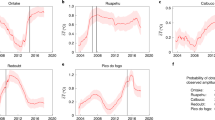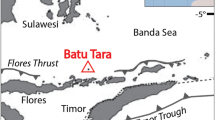Abstract
Nyamuragira volcano is one of the most active African volcanoes. Eruptions have been occurring every 3–4 years throughout the last century. Here, we analyse satellite infrared data, collected by MODIS sensor to estimate the volcanic radiative power (VRP, in W) and energy (VRE; in J) released during the 2001, 2002, 2004, 2006–2007, 2010 and 2011–2012 eruptions. Based on the statistical distribution of VRP measurements, we found that thermal emissions at Nyamuragira fall into three distinct radiating regimes. The high-radiating regime occurs during the emplacement of poorly insulated lava flows and characterise most of the effusive activity. The moderate-radiating regime is associated with open-vent activity (Strombolian explosions and/or lava lake activity) eventually accompanied by the emplacement of short-lived and well-insulated flows. A third radiating regime (low-radiating regime) occurs during periods, which may last weeks to months, that follow each eruption and are associated with the cooling of the effused lava flows. By applying the radiant density approach to MODIS-derived VRP we also estimated the time-averaged lava discharge rates (TADR; in m3 s−1) and we analysed the effusive trends of the above eruptions. We found that the transition between the effusive and open-vent activity typically takes place when TADR reduces to low values (<5 m3 s−1) and marks a change in the eruptive style of the volcano. Finally, we observed a clear correlation between the volume of erupted lava and its cooling time. This suggests that the average thickness of the analysed lava flows is more variable than previously thought and sheds light on the uncertainty in calculating erupted volumes assuming that lava flow areas have uniform thickness.










Similar content being viewed by others
References
Aoki K, Yoshida T, Yusa K, Nakamura Y (1985) Petrology and geochemistry of the Nyamuragira Volcano, Zaire. J Volcanol Geotherm Res 25:1–28
Bluth GJS, Carn SA (2008) Exceptional sulphur degassing from Nyamuragira volcano, 1979–2005. Int J Remote Sens 29(22):6667–6685. doi:10.1080/ 01431160802168434
Burt ML, Wadge G, Scott WA (1994) Simple stochastic modelling of the eruption history of a basaltic volcano: Nyamuragira, Zaire. Bull Volcanol 56(2):87–97
Calvari S, Lodato L, Steffke A, Cristaldi A, Harris AJL, Spampinato L, Boschi E (2010) The 2007 Stromboli flank eruption: chronology of the events, and effusion rate measurements from thermal images and satellite data. J Geophys Res 115(B4), B04201. doi:10.1029/2009JB006478
Carn SA, Bluth GJS (2003) Prodigious sulfur dioxide emissions from Nyamuragira volcano, D.R. Congo. Geophys Res Lett 30(23):2211
Chakrabarti R, Basu AR, Santo AP, Tedesco D, Vaselli O (2009) Isotopic and geochemical evidence for a heterogeneous mantle plume origin of the Virunga volcanics, Western rift, East African Rift system. Chem Geol 259:273–289. doi:10.1016/j.chemgeo.2008.11.010
Coppola D, Piscopo D, Staudacher T, Cigolini C (2009) Lava discharge rate and effusive pattern at Piton de la Fournaise from MODIS data. J Volcanol Geotherm Res 184(1–2):174–192
Coppola D, James MR, Staudacher T, Cigolini C (2010) A comparison of field- and satellite-derived thermal flux at Piton de la Fournaise: implications for the calculation of lava discharge rate. Bull Volcanol 72(3):341–356
Coppola D, Piscopo D, Laiolo M, Cigolini C, Delle Donne D, Ripepe M (2012) Radiative heat power at Stromboli volcano during 2000–2011: twelve years of MODIS observations. J Volcanol Geotherm Res 215–216:48–60
Coppola D, Laiolo M, Piscopo D, Cigolini C (2013) Rheological control on the radiant density of active lava flows and domes. J Volcanol Geotherm Res 249:39–48. doi:10.1016/j.jvolgeores.2012.09.005
Crisp J, Baloga S (1990) A method for estimating eruption rates of planetary lava flows. Icarus 85:512–515
Di Bartola C, Hirn B, Ferrucci F (2008) Spaceborne monitoring 2000–2005 of the Pu’u O’o-Kumaianaha (Hawaii) eruption by synergetic merge of multispectral payloads ASTER and MODIS. IEEE T Geosci Remote Sens 48(10):2848–2856
Gouhier M, Coppola D (2011) Satellite-based evidence for a large hydrothermal system at Piton de la Fournaise volcano (Reunion Island). Geophys Res Lett 38 (L02302). doi:10.1029/2010GL046183
Halmer MM, Schmincke HU, Graf HF (2002) The annual volcanic gas input into the atmosphere, in particular into the stratosphere: a global data set for the past 100 years. J Volcanol Geotherm Res 115:511–528. doi:10.1016/ S0377-0273(01)00318-3
Hamaguchi H, Zana N (1983) Introduction to volcanoes Nyiragongo and Nyamuragira. In: Hamaguchi H (ed) Volcanoes Nyiragongo and Nyamuragira: geophysical aspects. Tohoku University, Sendai, pp 1–6
Harris AJL, Baloga SM (2009) Lava discharge rates from satellite-measured heat flux. Geophys Res Lett 36 (L19302). doi: 10.1029/2009GL039717
Harris AJL, Blake S, Rothery DA (1997) A chronology of the 1991 to 1993 Mount Etna eruption using advanced very high resolution radiometer data: implications for real-time thermal volcano monitoring. J Geophys Res 102(B4):7985–8003
Harris AJL, Flynn LP, Keszthelyi L, Mounginis-Mark PJ, Rowland SK, Resing JA (1998) Calculation of lava effusion rates from Landsat TM data. Bull Volcanol 60:52–71
Harris AJL, Favalli M, Steffke A, Fornaciai A, Boschi E (2010) A relation between lava discharge rate, thermal insulation, and flow area set using lidar data. Geophys Res Lett 37 (L20308). doi:10.1029/2010GL044683
Harris AJL, Steffke A, Calvari S, Spampinato L (2011) Thirty years of satellite-derived lava discharge rates at Etna: implications for steady volumetric output. J Geophys Res 116 (B08204). doi:10.1029/2011JB008237
Head EM, Shaw AM, Wallace PJ, Sims KWW, Carn S (2011) Insight into volatile behavior at Nyamuragira volcano (D.R. Congo, Africa) through olivine-hosted melt inclusions. Geochem Geophys Geosyst 12 (Q0AB11). doi:10.1029/2011GC003699
Head EM, Maclean AL, Carn SA (2012) Mapping lava flows from Nyamuragira volcano (1967–2011) with satellite data and automated classification methods. Geomatics Nat Hazards Risk 4(2):119–144. doi:10.1080/19475705.2012.680503
Kasahara M (1983) Near-field tilt measurements related to the 1981–1982 Nyamuragira eruption. In: Hamaguchi H (ed) Volcanoes Nyiragongo and Nyamuragira: geophysical aspects. The Faculty of Science, Tohoku University, Sendai, pp 47–54
Koeppen WC, Patrick M, Orr T, Sutton J, Dow D, Wright R (2013) Constraints on the partitioning of Kilauea’s lavas between surface and tubed flows, estimated from infrared satellite data, sulfur dioxide flux measurements, and field observations. Bull Volcanol 75:216. doi:10.1007/s00445-013-0716-3
Pieri DC, Baloga SM (1986) Eruption rate, area, and length relationships for some Hawaiian lava flows. J Volcanol Geotherm Res 30:29–45
Ripepe M, Marchetti E, Ulivieri G, Harris AJL, Dehn J, Burton MR, Caltabiano T, Salerno GG (2005) Effusive to explosive transition during the 2003 eruption of Stromboli volcano. Geology 33:341–344
Rothery DA, Coppola D, Saunders C (2005) Analysis of volcanic activity patterns using MODIS thermal alerts. Bull Volcanol 67:539–556
Sharma K., Blake S., Self, S., Krueger A.J., (2004), SO2 emissions from basaltic eruptions, and the excess sulfur issue. Geophys Res Let 31 (L13612). doi:10.1029/2004GL019688
Shinohara H (2008) Excess degassing from volcanoes and its role on eruptive and intrusive activity. Rev Geophys 46 (RG4005). doi:10.1029/2007RG000244
Smets B, Wauthier C, d’Oreye N (2010) A new map of the lava flow field of Nyamulagira from satellite imagery. J Afri Earth Sci 58:778–786
Smithsonian Institution (2001) Nyamuragira. Bulletin Global Volcanism Network, Smithsonian Institution, 01/2001; 03/2001 (BGVN 26:01; 26:03)
Smithsonian Institution (2002) Nyamuragira. Bulletin Global Volcanism Network, Smithsonian Institution, 07/2002; 10/2002 (BGVN 27:07; 27:10)
Smithsonian Institution (2004) Nyamuragira. Bulletin Global Volcanism Network, Smithsonian Institution, 04/2004 (BGVN 29:04)
Smithsonian Institution (2010) Nyamuragira. Bulletin Global Volcanism Network, Smithsonian Institution, 08/2010 (BGVN 35:08)
Smithsonian Institution (2011) Nyamuragira. Weekly Reports. http://www.volcano.si.edu/world/volcano.cfm?vnum=0203-02=&volpage=weekly#Nov2011
Steffke AM, Harris AJL, Burton M, Caltabiano T, Salerno GG (2011) Coupled use of COSPEC and satellite measurements to define the volumetric balance during effusive eruptions at Etna, Italy. J Volcanol Geotherm Res 205:45–53. doi:10.1016/j.jvolgeores.2010.06.004
Toombs A, Wadge G (2012) Co-eruptive and inter-eruptive surface deformation measured by satellite radar interferometry at Nyamuragira volcano, D.R. Congo, 1996 to 2010. J Volcanol Geotherm Res 245–246:98–122
Ueki S (1983) Recent volcanism of Nyamuragira and Nyiragongo. In: Hamaguchi H (ed) Volcanoes Nyiragongo and Nyamuragira: geophysical aspects. Faculty of Science, Tohoku University, Sendai, pp 7–18
Virunga National Park (2012) at http://gorillacd.org/2012/04/25/nyamulagira-volcanos-latest-activity/
Wadge G (1981) The variation of magma discharge during basaltic eruptions. J Volcanol Geotherm Res 11:139–168
Wadge G, Burt L (2011) Stress field control of eruption dynamics at a rift volcano: Nyamuragira, D.R. Congo. J Volcanol Geotherm Res 207:1–15
Wallace PJ (2001) Volcanic SO2 emissions and the abundance and distribution of exsolved gas in magma bodies. J Volcanol Geotherm Res 108:85–106
Wright R, Pilger E (2008) Radiant flux from Earth’s sub-aerially erupting volcanoes. Int J Remote Sens 29(22):6443–6466. doi:10.1080/01431160802168210
Wright R, Blake S, Harris AJL, Rothery DA (2001) A simple explanation for the space-based calculation of lava eruption rates. Earth Planet Sci Lett 192:223–233
Wright R, Flynn L, Garbeil H, Harris A, Pilger E (2002) Automated volcanic eruption detection using MODIS. Remote Sens Environ 82:135–155
Wright R, Flynn LP, Garbeil H, Harris AJL, Pilger E (2004) MODVOLC: near-realtime thermal monitoring of global volcanism. J Volcanol Geotherm Res 135:29–49. doi:10.1016/j.jvolgeores.2003.12.008
Acknowledgements
We acknowledge Sonia Calvari, Geoff Wadge and an anonymous reviewer for providing useful comments and suggestions that greatly improved our earlier manuscript. We also acknowledge the NASA-LAADS (http://ladsweb.nascom.nasa.gov/) for providing level 1b MODIS data. Digital Elevation Model is courtesy of CGIAR (srtm.csi.cgiar.org). This research was supported by the Italian Ministry for Universities and Research (MIUR).
Author information
Authors and Affiliations
Corresponding author
Additional information
Editorial responsibility: S. Calvari
Electronic supplementary material
Below is the link to the electronic supplementary material.
ESM 1
Within the supplementary material we provided a full description of the method used to correct the VRP for MODIS band 21 saturation. (PDF 257 kb)
Rights and permissions
About this article
Cite this article
Coppola, D., Cigolini, C. Thermal regimes and effusive trends at Nyamuragira volcano (DRC) from MODIS infrared data. Bull Volcanol 75, 744 (2013). https://doi.org/10.1007/s00445-013-0744-z
Received:
Accepted:
Published:
DOI: https://doi.org/10.1007/s00445-013-0744-z




